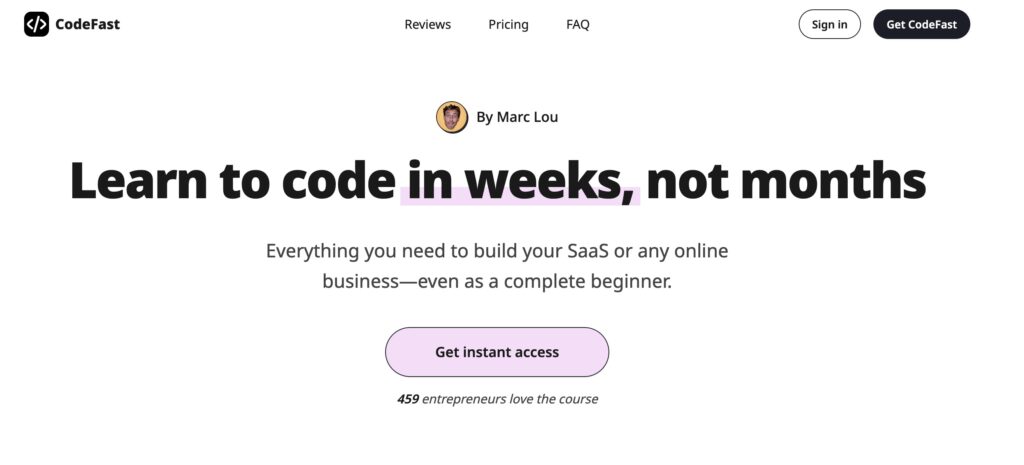Coding as a skill has evolved tremendously over the years. While traditional courses demand months or even years of your time, focusing on complex theories and endless coding practice, aspiring entrepreneurs need something different.
They require a streamlined approach that emphasizes quick results, which is exactly what modern entrepreneurial coding courses offer. These are designed not only to teach you the essential principles of coding but also how to launch and sustain successful online businesses rapidly.
Today, we will review the New course from Marc Lou.
TL;DR
If you’re considering CodeFast course, here’s what you need to know:
This is primarily a coding course focused on web development and SaaS creation, with 200 concise lessons:
- Best for: Entrepreneurs wanting to build web apps/SaaS products – not designed for traditional coding career paths
- Course structure: Covers mindset, frontend (CSS/JavaScript), and backend development including authentication and logins
- Major strength: No fluff, straight-to-the-point lessons focused on practical implementation
- Main value: Teaches the essential 10% you need to know to build and ship products quickly
- Ideal for: People who want structured learning versus trying to piece together free YouTube tutorials
- Not recommended if: You only want the marketing/mindset content (first section) or don’t have time to commit to all 200 lessons
The essentials of entrepreneurial coding

Learn what matters
Traditional computer science courses often dive deep into topics such as data structures, algorithms, and Big O notation. But if you’re an entrepreneur, mastering these elements isn’t usually necessary from day one. Instead, focus on learning the fundamentals that allow you to build, deploy, and iterate quickly.
This includes understanding front-end libraries like React and Next.js, as well as back-end systems that enable things like user authentication and database management using frameworks like MongoDB.
By concentrating solely on what’s necessary for a minimally viable product (MVP), you can start gathering feedback early in the process. This approach contrasts sharply with spending countless hours on theory-heavy content. The ultimate goal is functionality over formality, enabling quicker iterations and adaptations based on real-world insights.
Using AI to boost productivity
One of the most striking features of entrepreneurial coding is the integration of Artificial Intelligence (AI). By leveraging AI tools, you can automate repetitive tasks, generate code snippets, and even design user interfaces more efficiently. This doesn’t just save time; it makes the entire process more accessible for those who may not have extensive coding experience.
For example, language models can assist in writing and debugging code, while specific AI-powered platforms can streamline the deployment and maintenance of your applications. Such technological aids minimize entry barriers, allowing more room for creativity and innovation.
Building your first SaaS application
Frontend development essentials
Your first Software-as-a-Service (SaaS) application should focus on core components such as user interface (UI) and user experience (UX). Here’s a checklist to get you started:
- Next.js application structure
- React components—high-level building blocks
- Tailwind CSS—for responsive and visually appealing designs
- Dynamic pages and forms
- Copywriting essentials—to make your UI intuitive
- Responsive design techniques
Each of these elements contributes to making your application both functional and attractive, directly impacting user satisfaction and engagement.
Backend and security
The backend is where the magic happens—it handles data management, user authentication, and various other critical functions. When developing an entrepreneurial application, focus on aspects like Magic Link authentication, Google OAuth login, and database management through MongoDB. Being proficient in these areas ensures that your application performs reliably and keeps user data secure.
Another crucial aspect is integrating seamless payment solutions like Stripe or LemonSqueezy subscriptions. This allows monetization from the get-go, turning your application into a viable business model rapidly. Additionally, keep updating yourself on security best practices to safeguard against potential vulnerabilities.
Continuous improvement and learning
The lean startup methodology
Coding as an entrepreneur isn’t just about getting a product out there; it’s also about iterative improvement. The Lean Startup methodology provides a framework for this. It comprises building a minimal viable product, measuring its performance, and learning from user feedback. The cycle then repeats, ensuring continuous enhancement and alignment with market needs.
This iterative process means you’re always on the lookout for new ways to optimize and refine your product. Over time, your coding proficiency will naturally improve alongside your application, reflecting a constant state of growth and adaptation.
Never stop learning
The tech landscape evolves rapidly, and what you learn today might be obsolete tomorrow. Keep up-to-date by following industry news, participating in forums or communities, and taking advanced courses when needed. Real-world projects shared by peers also serve as valuable case studies, highlighting novel approaches and innovations worth considering.
This continuous learning mindset helps keep your skills relevant and sharpens your entrepreneurial edge. Moreover, staying engaged with recent trends equips you with the knowledge to incorporate emerging technologies, thus enhancing the overall quality and functionality of your projects.
Efficiency and practicality over perfection
Avoiding common pitfalls
When starting out, many developers spend too much time perfecting their code. Although this can be beneficial in some contexts, it might delay your progress in an entrepreneurial setting. Entrepreneurs prioritize efficiency and practicality, valuing functional solutions that can be iterated upon over theoretically ‘perfect’ ones.
This pragmatic approach translates into faster launch times and the ability to pivot based on real user interactions, rather than hypothesized scenarios. Hence, aim for a balance between quality and speed, keeping the main focus on delivering a working product swiftly.
Listen to your users
User feedback is gold. Entrepreneurs thrive on it as it guides future development stages and highlights key areas of improvement. When you’ve built a product, actively seek reviews and testimonials. Use surveys, direct communication channels, and analytical tools to gather insightful data.
Listening attentively to your users not only builds trust but also ensures that your application remains relevant and useful. Each piece of feedback is an opportunity for refinement, leading to a superior product that stands out in a competitive market.


